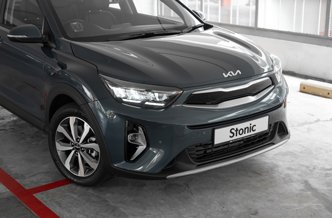Volkswagen T-Cross R-Line 1.0 (A) vs Kia Stonic SX 1.0 (A)
23 Dec 2022|18,239 views
Volkswagen T-Cross
More advanced cockpit
More versatile cabin and boot
Plusher ride
Higher price
Kia Stonic
More approachable
More driver-focussed cockpit
Better handling
Less expensive
COE premiums have put brand new cars out of reach of many, but for buyers still in the market for a set of wheels, entry-level 1.0-litre compact crossovers can still be a viable option - especially if the models punch above their weight.
In the blue corner we have the Stonic. Updated last year, the Stonic received a boost in performance and efficiency, and more recently, has been fitted with the new 'Kia' badge.
In the orange corner is the T-Cross, the smallest crossover in VW's lineup. Though compact, it calls attention to itself by being available in a variety of hip colours. And like the Stonic, it is more well-equipped than you'd initially expect.
Now that both contenders are here, let's get this bout started!
Sizing up the competition
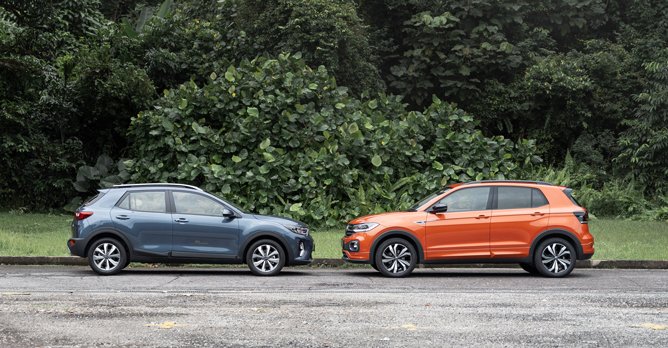
Chalk up the latter to the larger grille and fog lamps, and higher shoulder line, all of which make the T-Cross resemble a larger VW SUV.
At the rear, the T-Cross' C-shaped taillights are 'linked' by a reflective strip, which apart from being decorative, enhances the impression of width.
Now, despite looking smaller than the T-Cross, the Stonic is actually the larger crossover here. At 4,140mm, it is 32mm longer than the T-Cross, and more significantly, its 2,580mm wheelbase is 29mm lengthier as well.
I find the Stonic's simpler and cleaner styling more appealing. Yes, there's still a 'tiger nose' grille, but its size is in proportion to the rest of the car. It's a crossover that resembles a supermini, and it does not try to look larger than it is.
Different strokes
 | 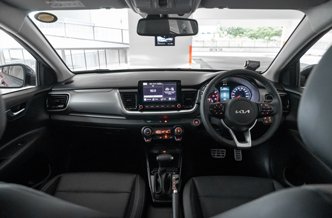 |
Hop into the T-Cross and the first thing you notice is the full digital dashboard, which consists of a 10.25-inch instrument cluster and 8.0-inch infotainment system.
Both are intuitive, and even first time car owners should get the hang of the menu layouts before long. In terms of connectivity, there are two USB-C ports to provide faster charging for smartphones. For comfort, the T-Cross offers dual-zone climate control (versus a single zone in the Stonic).
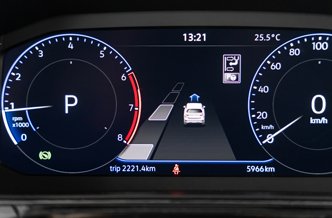 | 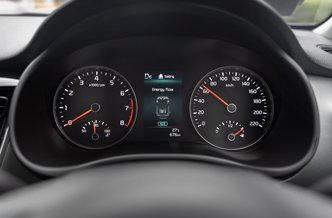 |
And despite not having a fancy instrument panel, the analogue dials work just fine and, in fact, are easier to read at a glance, since the digital display in the centre is relatively small. Scrolling through the menus here is no issue either.
As for the infotainment, the Stonic also has an 8.0-inch touchscreen. Apple CarPlay and Android Auto are standard, and the former can even be used wirelessly. Neat. A single USB-A port, which is conveniently illuminated, and a 12V socket are provided for charging needs.
Occupant space and practicality
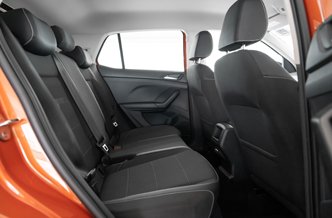 | 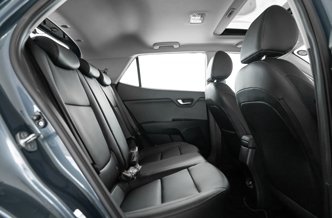 |
Backseat space is decent for adults up to 1.75m tall, but given the overall width, putting three adults here is a squeeze. Occupants have access to two more USB-C ports, while the Stonic only offers a single USB-A connection.
That said, the Stonic's longer wheelbase does translate into more legroom compared to the T-Cross. Ingress and egress are easier as well, thanks to the lower ride height.
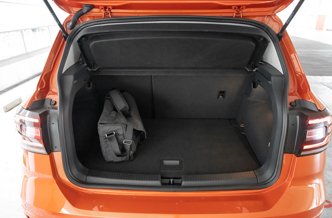 | 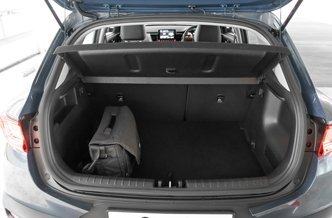 |
If cabin storage is an issue, one's belongings can always be placed in the Stonic's 352-litre boot. Folding down the rear backrests expands this capacity to 1,155 litres, so bulkier items can be loaded.
The T-Cross is ahead when it comes to boot volume though, which stands at 385 litres. Moving the rear bench forward increases it to 455 litres, and folding the backrests liberates the full 1,281 litres, so you can even use the car for moving house.
The fun quotient
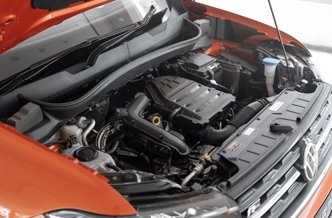 | 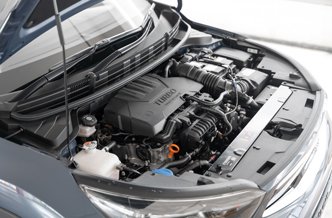 |
Acceleration aside, the powertrain's actual edge in this story is its refinement. It's quieter than expected, and complements the T-Cross' well-sorted suspension as well. The T-Cross feels like a larger SUV, though, and coupled with its taller height, does not lend itself well to enthusiastic driving.
The Stonic, on the other hand, prefers a keen driver at its helm. Like the T-Cross, it also has a turbocharged 1.0-litre in-line three engine producing 200Nm of torque, but a smidgen more power at 118bhp. On paper, the Stonic takes 10.4 seconds to finish the century sprint, but realistically, nobody can actually detect that extra 0.2 of a second.
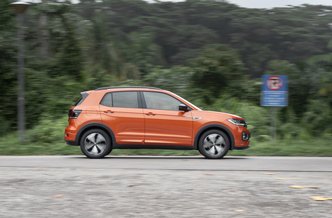 | 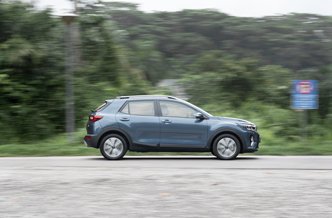 |
Indeed, the Stonic's exuberance is delightful. Sure, it's not as smooth as the T-Cross, but when you're gunning the engine and chucking it around corners with glee, it's hard to find anything to complain about, especially when the Stonic clearly enjoys such endeavours.
The Stonic also has another ace up its sleeve in the form of a 48V mild hybrid system. Apart from providing a smoother stop-start function, the mild hybrid also lets the crossover 'coast'. Under the right conditions, the engine can be switched off when the driver lifts his foot from the accelerator pedal, which helps to save fuel. The Stonic averages up to 21.3km/L, compared to the 18.5km/L figure managed by the T-Cross.
Reflections
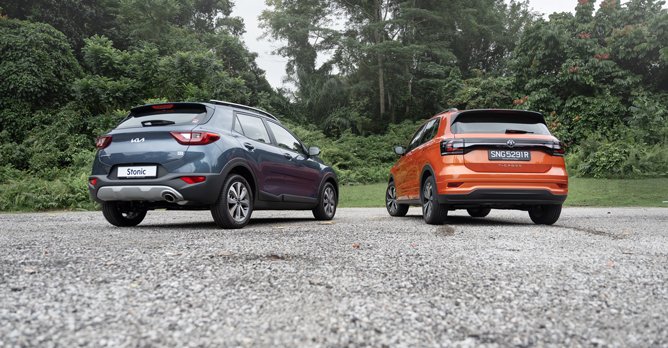
Thanks to the car's boxy shape and rear bench that can be slid fore and aft, the T-Cross easily adapts to the needs of different users. Its smooth powertrain and SUV styling, which today's buyers just love, add to its appeal.
Now, while the Stonic may not be as versatile or have as nifty a cabin as the T-Cross, but it makes up for these shortcomings by delivering more driving thrills, as well as being more driver-friendly and approachable. It's also more efficient, which can translate into lower running costs.
The Stonic's price tag can't be overlooked either. As of 9 December 2022, the SX variant starts from $136,999, whereas the T-Cross starts at $152,400, or a $15,401 premium. By outpunching the T-Cross on several key fronts, it's the Stonic that proves even harder to resist.
Looking to compare more cars? Check out these other Group Tests
Mazda CX-8 squares off against the Skoda Kodiaq
Audi A8 goes head-to-head with the Mercedes-Benz S-Class
Volvo XC60 B5 takes on the Jaguar F-Pace
Lexus NX 350 F Sport takes on the Audi Q5 and BMW X3
Mazda CX-5 meets the Volkswagen Tiguan
Nissan Qashqai faces off against the Skoda Karoq
Honda HR-V lines up alongside the Peugeot 3008
Mercedes-Benz CLA180 goes head-to-head with the BMW 216i Gran Coupe
Volkswagen T-Cross
More advanced cockpit
More versatile cabin and boot
Plusher ride
Higher price
Kia Stonic
More approachable
More driver-focussed cockpit
Better handling
Less expensive
COE premiums have put brand new cars out of reach of many, but for buyers still in the market for a set of wheels, entry-level 1.0-litre compact crossovers can still be a viable option - especially if the models punch above their weight.
In the blue corner we have the Stonic. Updated last year, the Stonic received a boost in performance and efficiency, and more recently, has been fitted with the new 'Kia' badge.
In the orange corner is the T-Cross, the smallest crossover in VW's lineup. Though compact, it calls attention to itself by being available in a variety of hip colours. And like the Stonic, it is more well-equipped than you'd initially expect.
Now that both contenders are here, let's get this bout started!
Sizing up the competition

Chalk up the latter to the larger grille and fog lamps, and higher shoulder line, all of which make the T-Cross resemble a larger VW SUV.
At the rear, the T-Cross' C-shaped taillights are 'linked' by a reflective strip, which apart from being decorative, enhances the impression of width.
Now, despite looking smaller than the T-Cross, the Stonic is actually the larger crossover here. At 4,140mm, it is 32mm longer than the T-Cross, and more significantly, its 2,580mm wheelbase is 29mm lengthier as well.
I find the Stonic's simpler and cleaner styling more appealing. Yes, there's still a 'tiger nose' grille, but its size is in proportion to the rest of the car. It's a crossover that resembles a supermini, and it does not try to look larger than it is.
Different strokes
T-Cross' cockpit (left) looks more high-tech than the Stonic's, but the latter's simpler and more driver-focussed layout has its own appeal
Both the Stonic and T-Cross have differing philosophies when it comes to their interiors. The Stonic keeps things simple and functional, while the T-Cross highlights technology and practicality.Hop into the T-Cross and the first thing you notice is the full digital dashboard, which consists of a 10.25-inch instrument cluster and 8.0-inch infotainment system.
Both are intuitive, and even first time car owners should get the hang of the menu layouts before long. In terms of connectivity, there are two USB-C ports to provide faster charging for smartphones. For comfort, the T-Cross offers dual-zone climate control (versus a single zone in the Stonic).
Park Assist (left) is standard in the T-Cross, but the Stonic's mild hybrid system impresses with its sailing ability
The Stonic delights in other ways, though. For starters, it's more driver-focused as the dashboard is angled towards the driver, and the seating position is more optimal and requires less adjustment. The lower dashboard means it's less intimidating for petite drivers, while the alloy pedals offer a nicer feel.And despite not having a fancy instrument panel, the analogue dials work just fine and, in fact, are easier to read at a glance, since the digital display in the centre is relatively small. Scrolling through the menus here is no issue either.
As for the infotainment, the Stonic also has an 8.0-inch touchscreen. Apple CarPlay and Android Auto are standard, and the former can even be used wirelessly. Neat. A single USB-A port, which is conveniently illuminated, and a 12V socket are provided for charging needs.
Occupant space and practicality
T-Cross (left) offers more headroom than the Stonic, but the latter's sunroof does give the cabin an airier feel
The T-Cross is better-suited to taller occupants who tend to carry more items, as it has larger storage points. The door bins, which are deeper and wider, are also handier. There's even a 'tray' on the dashboard, useful for drivers who swap between different sunglasses.Backseat space is decent for adults up to 1.75m tall, but given the overall width, putting three adults here is a squeeze. Occupants have access to two more USB-C ports, while the Stonic only offers a single USB-A connection.
That said, the Stonic's longer wheelbase does translate into more legroom compared to the T-Cross. Ingress and egress are easier as well, thanks to the lower ride height.
T-Cross' boot volume (left) is larger and more flexible than the Stonic's, but the latter does have a wider aperture to facilitate loading
Accommodations for the middle passenger are less awkward, too, since the floor 'hump' is low, and the centre console protrudes less compared to the one in the T-Cross. My only concern here is the smaller door pockets.If cabin storage is an issue, one's belongings can always be placed in the Stonic's 352-litre boot. Folding down the rear backrests expands this capacity to 1,155 litres, so bulkier items can be loaded.
The T-Cross is ahead when it comes to boot volume though, which stands at 385 litres. Moving the rear bench forward increases it to 455 litres, and folding the backrests liberates the full 1,281 litres, so you can even use the car for moving house.
The fun quotient
T-Cross 1.0-litre unit (left) is more polished, but the Stonic's engine is more responsive and has a nicer soundtrack to boot
The T-Cross is surprisingly peppy in spite of its lower power output. Beneath its bonnet is a turbocharged 1.0-litre three-cylinder that churns out 114bhp and 200Nm. Paired to a seven-speed dual-clutch transmission, the crossover hits 100km/h in 10.2 seconds.Acceleration aside, the powertrain's actual edge in this story is its refinement. It's quieter than expected, and complements the T-Cross' well-sorted suspension as well. The T-Cross feels like a larger SUV, though, and coupled with its taller height, does not lend itself well to enthusiastic driving.
The Stonic, on the other hand, prefers a keen driver at its helm. Like the T-Cross, it also has a turbocharged 1.0-litre in-line three engine producing 200Nm of torque, but a smidgen more power at 118bhp. On paper, the Stonic takes 10.4 seconds to finish the century sprint, but realistically, nobody can actually detect that extra 0.2 of a second.
T-Cross (left) offers a more pliant ride, but keen drivers will prefer the Stonic for its agility and engaging driving dynamics
What is palpable, though, is the Stonic's responsiveness to throttle inputs. Even with the drive setting in 'Normal', the car is always eager to go, putting a smile on the driver's face.Indeed, the Stonic's exuberance is delightful. Sure, it's not as smooth as the T-Cross, but when you're gunning the engine and chucking it around corners with glee, it's hard to find anything to complain about, especially when the Stonic clearly enjoys such endeavours.
The Stonic also has another ace up its sleeve in the form of a 48V mild hybrid system. Apart from providing a smoother stop-start function, the mild hybrid also lets the crossover 'coast'. Under the right conditions, the engine can be switched off when the driver lifts his foot from the accelerator pedal, which helps to save fuel. The Stonic averages up to 21.3km/L, compared to the 18.5km/L figure managed by the T-Cross.
Reflections

Thanks to the car's boxy shape and rear bench that can be slid fore and aft, the T-Cross easily adapts to the needs of different users. Its smooth powertrain and SUV styling, which today's buyers just love, add to its appeal.
Now, while the Stonic may not be as versatile or have as nifty a cabin as the T-Cross, but it makes up for these shortcomings by delivering more driving thrills, as well as being more driver-friendly and approachable. It's also more efficient, which can translate into lower running costs.
The Stonic's price tag can't be overlooked either. As of 9 December 2022, the SX variant starts from $136,999, whereas the T-Cross starts at $152,400, or a $15,401 premium. By outpunching the T-Cross on several key fronts, it's the Stonic that proves even harder to resist.
Looking to compare more cars? Check out these other Group Tests
Mazda CX-8 squares off against the Skoda Kodiaq
Audi A8 goes head-to-head with the Mercedes-Benz S-Class
Volvo XC60 B5 takes on the Jaguar F-Pace
Lexus NX 350 F Sport takes on the Audi Q5 and BMW X3
Mazda CX-5 meets the Volkswagen Tiguan
Nissan Qashqai faces off against the Skoda Karoq
Honda HR-V lines up alongside the Peugeot 3008
Mercedes-Benz CLA180 goes head-to-head with the BMW 216i Gran Coupe
Car Information
Volkswagen T-Cross
CAT A|Petrol|18.5km/L
Horsepower
85kW (114 bhp)
Torque
200 Nm
Acceleration
10.2sec (0-100km /hr)
Kia Stonic Mild Hybrid 1.0T SX (A)
CAT A|Petrol-Electric|21.3km/L
Horsepower
88kW (118 bhp)
Torque
200 Nm
Acceleration
10.4sec (0-100km /hr)
This model is no longer being sold by local distributor
All Used Kia Stonic Mild HybridThank You For Your Subscription.























































